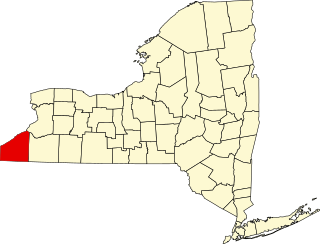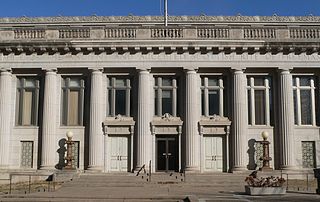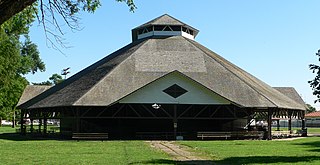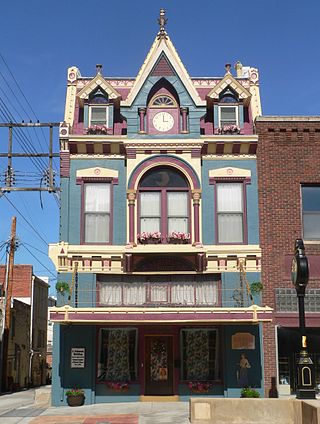
Glen Echo Park is an arts and cultural center in Glen Echo, Maryland, a suburb of Washington, D.C. Located about 9 miles (14 km) northwest of the city's downtown area, the park's site was initially developed in 1891 as a National Chautauqua Assembly.

This is a list of the National Register of Historic Places listings in Chautauqua County, New York.

Midway State Park, located in Maple Springs, New York, was established in 1898 by the Jamestown & Lake Erie Railway as a picnic ground. Today, it is recognized as the fifteenth-oldest continually operating amusement park in the United States, and the fifth-oldest remaining trolley park of the thirteen still operating in the United States.

The U.S. Capitol Gatehouses and Gateposts — designed circa 1827 by celebrated architect Charles Bulfinch — originally stood on the grounds of the United States Capitol in Washington, D.C. Two of the gatehouses are listed on the National Register of Historic Places in their new locations.

This is a list of the National Register of Historic Places listings in Pawnee County, Nebraska.

This is a list of the National Register of Historic Places listings in Gage County, Nebraska.

The Fisher Hill Reservoir and Gatehouse are historic elements of the public water supply for the Greater Boston area.

Westfield is a historic train station located at Westfield in Chautauqua County, New York. It was constructed in 1904, for the Lake Shore and Michigan Southern Railway. It is a 1+1⁄2-story brick, terra cotta, and sandstone structure in the Romanesque style. It served as the main transfer point for rail passengers destined for the Chautauqua Institution. The Jamestown, Westfield and Northwestern Railroad interurban, serving the eastern part of Chautauqua used the station. The Chautauqua Traction Company, serving the Chautauqua hamlet, used the Nickel Plate Railroad's station in Westfield.

This is a list of the National Register of Historic Places listings in Burt County, Nebraska.
Chautauqua Pavilion may refer to:

The Outing Club is located in the central part of Davenport, Iowa, United States. It has been listed on the National Register of Historic Places since 1977. In 1985 it was included as a contributing property in the Vander Veer Park Historic District.

The Scottish Rite Temple in Lincoln, Nebraska is a building from 1916. It was listed on the National Register of Historic Places in 1986.

The Chautauqua Park Historic District is located on the north side of Des Moines, Iowa, United States. It has been listed on the National Register of Historic Places since 1990. It is part of the Suburban Development in Des Moines Between the World Wars, 1918--1941 MPS.

The Chautauqua Pavilion is an octagonal pavilion located in Chautauqua Park in Hastings, Nebraska. The pavilion was constructed in 1907 for summer Chautauqua assemblies in Hastings. According to the Historic American Engineering Record, the pavilion's design is unique; in fact, the HAER does not have a name for certain design elements used in the pavilion. The building's pyramidal roof is supported by columns along the pavilion's perimeter; a triangular truss atop the columns acts as the pavilion's superstructure. A vent at the top of the roof is supported by a Howe truss. A stage and orchestra pit are located inside the pavilion, though the majority of the space inside the pavilion is open, allowing a variety of activities to be held there. The Hastings chapter of the Chautauqua movement held independent assemblies at the pavilion until 1913, when it merged with the national movement. Hastings continued to host Chautauqua events until the 1920s, when the movement declined due to the rise of film and radio.

The Taylorville Chautauqua Auditorium is a Chautauqua auditorium located in Manners Park in Taylorville, Illinois. The auditorium was built in 1916 to house Chautauqua assemblies in Taylorville. Chautauqua was an adult educational movement which sent lecturers, educators, and musicians to assemblies in towns throughout the country during the early 20th century. In Taylorville, Chautauqua assemblies met eight days each year from 1914 through 1928. Lecturers and entertainers who came to the Chautauqua in Taylorville include William Howard Taft, William Jennings Bryan, Helen Keller and Anne Sullivan, Billy Sunday, Irvin S. Cobb, Alvin York, Harry Lauder, and the Chicago Symphony Orchestra.

The Chautauqua Pavilion is a historic structure located in City Park in Riverton, Iowa, United States. William "Coin" Harvey, a political ally of William Jennings Bryan, founded a political fraternal order known as the Patriots of America. Fremont County, Iowa was said to have the largest number of members of any county in the US in the organization. It was selected to have an experimental structure to house encampments of the Patriots. Harvey donated $500 towards its construction in the Riverton city park. Within a few years the organization died out, and the pavilion was used for summer Chautauqua shows, Sunday school and church services, school graduations and May Day observances. The 70-foot (21 m) diameter structure is 35 feet (11 m) high in the center and 9 feet (3 m) high at the eaves. It is capped with a conical-shaped roof and open on the sides. The pavilion was listed on the National Register of Historic Places in 1976.

Chautauqua Park is a historic pavilion located in Red Oak, Iowa, United States. The first Chautauqua in Iowa was established at Clear Lake, Iowa in 1876, and by the 1920s there were as many as 500 Chautauqua assemblies in the state. Most of the structures used for the organization's functions in Iowa were tents, but Red Oak became the exception when this pavilion was built in 1908. The circular structure was built for about $5,200, and it had a seating capacity of between 3,500 and 5,000. Speakers on the inaugural program included orator and politician William Jennings Bryan, social reformer Jane Addams, Wisconsin Governor Robert M. La Follette, and evangelist Gipsy Smith. It continued to host annual Chautauqua programs until 1929. Chautauqua Park was listed on the National Register of Historic Places in 1972.

Rockville Chautauqua Pavilion, also known as Beechwood Park Pavilion, is a historic Chautauqua pavilion located at Rockville, Parke County, Indiana. The pavilion was built in 1913, and is a roughly octagonal heavy timber-frame building. It has a raised 1+1⁄2-story, clerestory square section with a decked hipped roof. Also on the property are the contributing park entry gates (1928), a picnic shelter, and a water fountain. The property hosted annual summer chautauquas from 1913 to 1930.
The American School of Wild Life Protection Historic District is a nationally recognized historic district located on the north side of McGregor, Iowa, United States. It was listed on the National Register of Historic Places in 1991. At the time of its nomination the district consisted of 30 resources, including 17 contributing buildings, one contributing site, one contributing structure, nine noncontributing buildings, two noncontributing sites. The American School of Wild Life Protection was established in 1919 in a resort area known as McGregor Heights. The purpose of the school was to promote resource conservation values among the public. It grew out legislation in 1918 that established state parks in Iowa. The school also promoted the idea of establishing a national park in the Upper Mississippi River Valley, and after that did not come about, the Upper Mississippi River National Wildlife and Fish Refuge. The school continued in existence until 1941.

The J. Schmuck Block is a historic three-story commercial and residential building in Beatrice, Nebraska, United States. It was built in 1887 for John Schmuck, a German immigrant and cobbler, who used the basement as a tavern and rented the first floor to dry goods stores and the second floor to tenants. The Beatrice Morning Sun had its offices here for more than four decades. The building has been listed on the National Register of Historic Places since July 2, 2008.




















